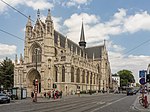Holy Trinity, Brussels
Anglican cathedrals in EuropeAnglican church buildings in BelgiumCathedrals in BelgiumChurches in BrusselsDiocese in Europe ... and 2 more
Gothic Revival church buildings in BelgiumIxelles

The Pro-Cathedral of the Holy Trinity (French: Pro-cathédrale de la Sainte-Trinité; Dutch: Prokathedraal van de Heilige Drievuldigheid) is an Anglican Pro-Cathedral in Ixelles, a municipality of Brussels, Belgium. It is part of the Diocese in Europe of the Church of England. The church is located at 29, rue Capitaine Crespel/Kapitein Crespelstraat, near the Avenue Louise/Louizalaan.
Excerpt from the Wikipedia article Holy Trinity, Brussels (License: CC BY-SA 3.0, Authors, Images).Holy Trinity, Brussels
Rue Capitaine Crespel - Kapitein Crespelstraat,
Geographical coordinates (GPS) Address Nearby Places Show on map
Geographical coordinates (GPS)
| Latitude | Longitude |
|---|---|
| N 50.83527 ° | E 4.357719 ° |
Address
Rue Capitaine Crespel - Kapitein Crespelstraat 25
1050
Belgium
Open on Google Maps









